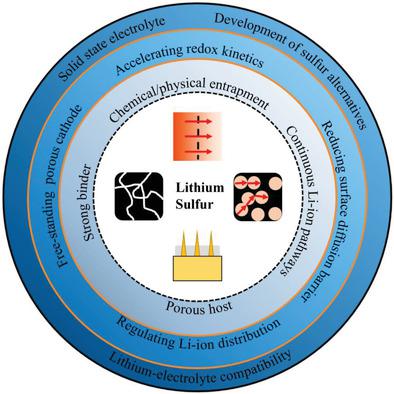当前位置:
X-MOL 学术
›
Adv. Energy Mater.
›
论文详情
Our official English website, www.x-mol.net, welcomes your feedback! (Note: you will need to create a separate account there.)
Strategies toward High‐Loading Lithium–Sulfur Battery
Advanced Energy Materials ( IF 27.8 ) Pub Date : 2020-03-20 , DOI: 10.1002/aenm.202000082 Yin Hu 1 , Wei Chen 1 , Tianyu Lei 1 , Yu Jiao 2 , Jianwen Huang 1 , Anjun Hu 1 , Chuanhui Gong 1 , Chaoyi Yan 1 , Xianfu Wang 1 , Jie Xiong 1
Advanced Energy Materials ( IF 27.8 ) Pub Date : 2020-03-20 , DOI: 10.1002/aenm.202000082 Yin Hu 1 , Wei Chen 1 , Tianyu Lei 1 , Yu Jiao 2 , Jianwen Huang 1 , Anjun Hu 1 , Chuanhui Gong 1 , Chaoyi Yan 1 , Xianfu Wang 1 , Jie Xiong 1
Affiliation

|
Lithium–sulfur (Li–S) batteries, due to the high theoretical energy density, are regarded as one of the most promising candidates for breaking the limitations of energy‐storage system based on Li‐ion batteries. Tremendous efforts have been made to meet the challenge of high‐performance Li–S batteries, in which a sulfur loading of above 5 mg cm−2 delivers an areal capacity higher than 5 mAh cm−2 without compromising specific capacity and cycling stability for practical applications. However, serious problems have been exposed during the scaling up of the sulfur loading. In this review, based on mechanistic insights into structural configuration, catalytic conversion, and interfacial engineering, the problems and corresponding strategies in the development of high‐loading Li–S batteries are highlighted and discussed, aiming at bridging the gap between fundamental research and practical cell‐level designs. Stemming from the current achievements, future directions targeting the high‐energy‐density Li–S batteries for commercialization are proposed.
中文翻译:

高负荷锂硫电池的策略
锂硫(Li–S)电池由于理论能量密度高,被认为是打破基于锂离子电池的储能系统局限性的最有希望的候选人之一。为了应对高性能Li–S电池的挑战,已经做出了巨大的努力,其中硫负荷超过5 mg cm -2时提供的面积容量高于5 mAh cm -2在不影响实际应用的比容量和循环稳定性的前提下。然而,在按比例增加硫负荷期间已经暴露出严重的问题。在这篇综述中,基于对结构构造,催化转化和界面工程的机械洞察力,着重讨论了高负载锂-硫电池开发中的问题和相应的策略,旨在弥合基础研究与实践之间的差距。单元级设计。从目前的成就出发,提出了针对高能量密度Li-S电池商业化的未来方向。
更新日期:2020-03-20
中文翻译:

高负荷锂硫电池的策略
锂硫(Li–S)电池由于理论能量密度高,被认为是打破基于锂离子电池的储能系统局限性的最有希望的候选人之一。为了应对高性能Li–S电池的挑战,已经做出了巨大的努力,其中硫负荷超过5 mg cm -2时提供的面积容量高于5 mAh cm -2在不影响实际应用的比容量和循环稳定性的前提下。然而,在按比例增加硫负荷期间已经暴露出严重的问题。在这篇综述中,基于对结构构造,催化转化和界面工程的机械洞察力,着重讨论了高负载锂-硫电池开发中的问题和相应的策略,旨在弥合基础研究与实践之间的差距。单元级设计。从目前的成就出发,提出了针对高能量密度Li-S电池商业化的未来方向。

























 京公网安备 11010802027423号
京公网安备 11010802027423号